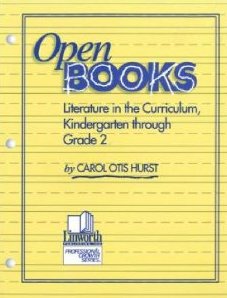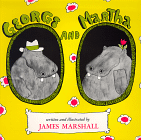Carol Hurst's Children's Literature Newsletter Spring 1999. Page 5.
by Carol Hurst and Rebecca Otis.
Featured Author: James Marshall

This is an excerpt from Open Books: Literature in the Curriculum by Carol Otis Hurst. Linworth, 1999. ISBN 0938865773. Order Online.
His Life:
James Marshall was born in San Antonio, Texas where his father worked for the railroad and had a dance band. James Marshall studied to play the viola and intended to have a musical career. Then his hand was injured during an airplane flight and his musical career was finished. He met Harry Allard, with whom he later wrote many picture books, when he was a student at Trinity College. James Marshall taught Spanish in a Catholic school near Boston upon graduation from college.
His first book, George and Martha, was inspired by a famous play, "Who's Afraid of Virginia Wolf" in which the main characters were named George and Martha.
For many years he divided his time between an apartment in New York City and his home in Mansfield Hollow, Connecticut. James Marshall died in October, 1992.
His Work in General:
James Marshall's work is usually gently humorous. He has several books in series: Miss Nelson, George & Martha, The Cut-Ups, The Stupids and The Rats, for instance. In those books, his characters change very little. His fairy tale renditions are full of sly humor.
Things You Might Like to Do with His Work in General:Watch for the fat cats which he puts in almost every book. Also notice the stacks of items, often about to fall over which are reminiscent of Dr. Seuss's books about the Cat in the Hat.
Notice the things about Texas that he puts in the Miss Nelson series.
James Marshall's work can be categorized as fairy tale renditions, series such as The Cut-ups, Miss Nelson, and George & Martha. Look at many books in one series and then try to decide what Marshall is trying to tell us.
(Continued Below)
Advertisement:
Books Written & Illustrated by James Marshall:
The Cut-Ups at Camp Custer. Puffin, 1991 ISBN 0140508171. Paperback.
Spud and Joe are together again. Spud's mother knows it's trouble and says as they head off, "That camp will never be the same". Then they find out that the camp director is none other than their old nemesis, school principal Mr. Spurgle and he's ready for them. Or so he thinks.
Activity: Compare Mr. Spurgle's nephew, Charles Andrew Frothingham with the Grand Duke Wilfred in Dr. Seuss's Five Hundred Hats of Bartholomew Cubbins.
Activity: With a name like Frothingham, Charles Andrew is bound to be a bit prissy. Find other stuffy names in picture books.
The Cut-ups Carry On. Viking, 1990 ISBN 0670816450. Library Binding. Paperback.
Spud and Joe are indignant when their parents enroll them in a dance class until they find out about a dance contest where the prize is a lunar walker. Their competitive spirit is aroused. Their chances take a nose dive, however, when they see that the best girl dancer has teamed up with the dreadful Charles Andrew Frothingham.
Activity: Organize your own dance contest. Decide on and publish a list of rules, criteria for prizes and, of course, the prizes.

George and Martha. Houghton, 1973 ISBN 0395166195. Library Binding. Paperback. Cassette.
In this first book about the hippo friends, five short stories give us the tale of "Split Pea Soup", "The Flying Machine", "The Tub", "The Mirror", and "The Tooth. Always the pair manages to get past the minor difficulties in a close friendship.
Activity: Make a list of the events in the stories. Beside each event, draw a picture of how George and Martha feel about it.
George and Martha: The Complete Stories of Two Best Friends. Houghton, 1997 ISBN 0395851580. Library Binding.
There are 340 pages in this outsized book but the friends are also outsized so it seems appropriate. Here are all the George and Martha stories in one volume.
Activity: Read through the stories and find the places where you would have been angry, annoyed or upset if your friend was like either George or Martha. What would you have done?
Rats on the Roof and Other Stories. Dial, 1991 ISBN 0803708343. Hardcover. Paperback.
It's not only rats but sheep, wolves, mice, frogs and cats in these funny short stories. Frog legs are a source of pride to the frog until he reads a recipe for frog legs. Birds talk a brontosaurus out of destroying an owl's nest by telling him how disgusting they will taste. At every turn there is humor and all villains are foiled in unpredictable ways.
Activity: Read aloud your favorite tale from either of the "Rat Collections." Use a prop to introduce your reading.
Wings: A Tale of Two Chickens. Viking, 1988 ISBN 0140505792. Paperback.
Winnie the chicken refuses to read and so is missing some information when a fox offers her a ride in his balloon. Fortunately her friend Harriet has better sense and manages to rescue her.
Activity: Compare the attitudes of Winnie with those of Petunia in the book by that name by Roger Duvoisin.
(Continued Below)
Advertisement:
James Marshall's Fairy Tale Renditions:
Cinderella. Little Brown, 1992 ISBN 0316483036. Paperback. Paperback.
Karlin's text sticks pretty much to the familiar tale although there's only one ball and the fairy godmother moves in with them at the end. It's Marshall's illustrations that make up most of the humor. Watch the dogs and the cats.
Goldilocks and the Three Bears. Puffin, 1998 ISBN 0140563660. Paperback. Hardcover.
Marshall's Goldilocks is chubby and opinionated as she follows the usual routine of breaking into the bears' house.
Hansel and Gretel. Dial, 1990 ISBN 0803708270. Hardcover. Paperback.
It's hard to believe that even Marshall could find humor in this grimmest of fairy tales but he does.
Red Riding Hood. Dutton, 1987 ISBN 0803703449. Hardcover. Paperback.
There's humor through this one from the first words of the debonair wolf to the chubby little girl to the last words of Grandma, a dedicated reader.
Three Little Pigs. Dutton, 1989 ISBN 0803705913. Hardcover. Paperback.
One of the pigs survives in this zany rendition of the familiar tale.
Activities: Find the humor in each of Marshall's renditions and chart it in a manner similar to this:
| Title | Main Characters | Funny Details in the Illustrations | Funny Details in the Text |
Books by Other Authors Illustrated by James Marshall
Allard, Harry. Miss Nelson Has a Field Day. Houghton, 1985 ISBN 0395366909. Library Binding. Paperback. Cassette.
It's Viola Swamp to the rescue just in time to help the football team of the Horace B. Smedley School shape up to win a game.
Allard, Harry. Miss Nelson Is Back. Houghton, 1982 ISBN 0395329566. Library Binding. Paperback. Cassette.
This time Miss Nelson has to go away for a week and the kids are ready for a high old time, but Viola Swamp returns.
Allard, Harry. Miss Nelson Is Missing. Houghton, 1977 ISBN 0395252962. Library Binding. Paperback. Cassette.
This is the first of the Miss Nelson books. Miss Nelson is a kind teacher but the kids seem to have no respect for her or her rules. Then, Miss Nelson is replaced by Viola Swamp, a teacher so strict and unpleasant that the students beg for Miss Nelson's return.
Activity: You probably have guessed who Viola Swamp really is. What are the clues you used?
Allard, Harry. The Stupids Die. Houghton, 1981 ISBN 0395303478. Library Binding. Paperback.
When the lights go out, there's only one conclusion to be reached by the Stupid family: they must be dead.
Activity: Many people are offended when you call them "stupid". What might be better names for these people?
Allard, Harry. The Stupids Take Off. Houghton, 1989 ISBN 0395500680. Library Binding. Paperback.
Hoping to avoid one group of boring relatives, the Stupids take off in their plane only to encounter even more stupid relatives.
Activity: Some things about the Stupid family are like the sitcoms of "The Munsters" and "The Addams Family". Make a chart showing their likenesses and differences.
(Continued Below)
Advertisement:
![]()
Related Areas within Carol Hurst's Children's Literature Site
- Folk and Fairy Tales, Tongue-in-Cheek Versions, including one of James Marshall's. Featured Subject with activities, books and related links.
-
Art, Crafts and Artists in Books for Kids and Teens, Featured Subject article with discussion and activity ideas, and picture books, nonfiction and novels for the classroom:
http://www.carolhurst.com/subjects/art.html

